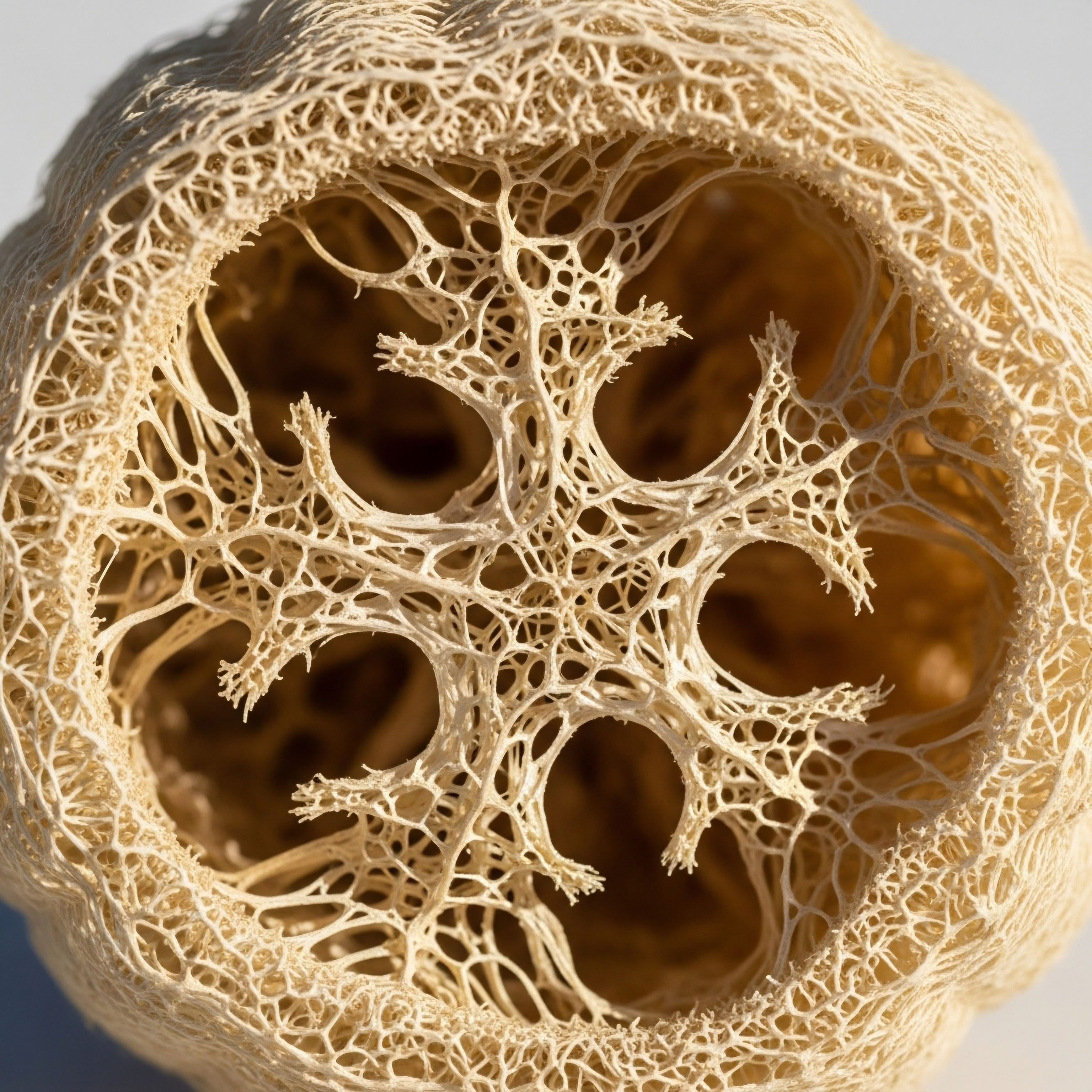

Fundamentals
You feel it before you can name it. A subtle shift in energy, a change in the way your body responds to exercise, or a new difficulty in shedding weight that once seemed manageable. This experience, a deviation from your personal baseline of vitality, is a deeply physical narrative.
Your biological story is written in your DNA, the foundational blueprint for your body. The way that story is read and expressed is governed by a layer of instructions known as the epigenome. Hormones are the principal editors of this instructional layer, constantly directing which chapters of your genetic book are read aloud and which remain silent.
Long-term hormonal adjustments, whether they occur naturally through life stages like perimenopause and andropause or through clinical protocols, are powerful epigenetic modulators. They function as a sustained signal to your cells, altering the very patterns of gene expression that dictate cellular function, metabolic rate, and the pace of aging.
These are not changes to the genetic code itself. They are changes to its accessibility and interpretation. Think of your DNA as a vast library of potential; the epigenome, under the influence of hormones like testosterone and estrogen, decides which books are taken off the shelf and put into active use.
Hormones act as epigenetic conductors, instructing genes on how to perform and thereby shaping your body’s daily physiological reality.

How Hormones Edit Your Genetic Story
This cellular editing process occurs primarily through two well-understood mechanisms. Each one acts like a different kind of annotation on your genetic manuscript, influencing how easily a gene can be read by the cellular machinery that translates genetic code into functional proteins.

DNA Methylation the Dimmer Switch
DNA methylation involves attaching a small molecule, a methyl group, directly onto a segment of DNA. This process often acts as a dimmer switch. In many cases, when a gene is methylated, its expression is turned down or silenced completely. Hormonal fluctuations have a direct impact on the enzymes that control this process.
For instance, estrogen levels can influence the methylation patterns of genes involved in cellular growth and proliferation, a mechanism with profound implications for health. A sustained change in your hormonal environment creates a new, stable pattern of methylation, effectively establishing a “new normal” for your gene expression.

Histone Modification Unspooling the Code
Your DNA is not a loose strand within your cells; it is tightly wound around proteins called histones, much like thread on a spool. For a gene to be read, the DNA must be unwound from these histones. Histone modification is the process of attaching chemical tags to the histones themselves, which can either tighten or loosen this winding.
Hormones can trigger enzymes that add “acetyl” tags, for example, which typically loosen the coil and make genes more accessible for expression. This process explains how hormonal signals can rapidly activate entire sets of genes related to functions like inflammation, metabolism, or tissue repair.


Intermediate
Understanding that hormones direct gene expression opens a new perspective on clinical interventions like hormone replacement therapy (HRT). These protocols are sophisticated tools for recalibrating the epigenetic signals that guide cellular behavior. When hormones like testosterone or estrogen are restored to optimal levels, the body receives a consistent set of instructions that can counteract the epigenetic drift associated with aging and metabolic decline.
The goal of such therapies is to rewrite the epigenetic annotations that are contributing to symptoms, thereby influencing the functional output of the genetic code.
For example, a man undergoing Testosterone Replacement Therapy (TRT) is doing more than just elevating a serum hormone level. He is providing his body with the necessary signaling molecule to adjust the epigenetic “dimmer switches” on genes critical for maintaining muscle mass, bone density, and insulin sensitivity.
Similarly, a woman using a carefully balanced protocol of estrogen and progesterone during menopause is influencing the histone modifications that control the expression of genes related to cognitive function, cardiovascular health, and body composition.
Hormonal optimization protocols function by providing the consistent epigenetic signals necessary to maintain youthful patterns of gene expression.

What Are the Epigenetic Targets of Hormonal Therapies?
Hormonal therapies do not act randomly; they influence specific sets of genes associated with their physiological roles. While the full scope is vast, clinical science has identified key areas where these epigenetic adjustments have a significant impact. These interventions are a direct conversation with the cellular machinery that controls your long-term health trajectory.
The table below outlines the primary epigenetic influence of key hormones used in optimization protocols. This illustrates how a balanced endocrine system orchestrates a wide array of biological functions through gene regulation.
| Hormone | Primary Epigenetic Mechanism | Key Gene Targets and Biological Outcomes |
|---|---|---|
| Testosterone | Influences DNA methylation and histone acetylation. | Upregulates genes for muscle protein synthesis (Actin, Myosin). Modulates genes involved in insulin signaling pathways (IRS-1), promoting metabolic efficiency. Downregulates genes associated with fat storage (adipogenesis). |
| Estrogen | Primarily affects histone acetylation and DNA methylation. | Regulates genes for bone density maintenance (osteoprotegerin). Influences expression of neuroprotective genes in the brain (BDNF). Modulates genes controlling collagen production and skin elasticity. |
| Progesterone | Modifies histone accessibility in target tissues. | Regulates genes involved in the uterine cycle. Influences expression of GABA receptors in the brain, contributing to mood stabilization and sleep quality. |
| Growth Hormone Peptides (e.g. Sermorelin) | Indirectly influences gene expression via signaling cascades. | Stimulates the expression of genes for cellular repair and regeneration. Upregulates genes involved in lipolysis (fat breakdown) and downregulates those for lipogenesis (fat creation). |

Clinical Protocols as Epigenetic Interventions
The design of modern hormonal therapies reflects a deep understanding of these epigenetic mechanisms. The goal is to mimic the body’s natural signaling rhythms to achieve a desired physiological state.
- Male TRT Protocols ∞ The standard weekly administration of Testosterone Cypionate provides a stable level of the primary signaling molecule. The inclusion of Gonadorelin supports the body’s own production axis, ensuring a more complete restoration of the natural hormonal cascade. Anastrozole is used to manage the conversion to estrogen, preventing an imbalance in epigenetic signals that could lead to unwanted side effects.
- Female Hormonal Protocols ∞ For women, protocols involving low-dose Testosterone, often combined with Progesterone, are designed to restore the complex interplay of signals that govern everything from metabolic health to mood. The choice of delivery method, whether injections or pellets, is aimed at providing a steady-state hormonal environment to promote consistent, favorable gene expression.
- Peptide Therapies ∞ Peptides like Ipamorelin or CJC-1295 work upstream. They signal the pituitary to release growth hormone, which then initiates a cascade of events that epigenetically modifies the expression of genes related to tissue repair, fat metabolism, and cellular health. This approach leverages the body’s own regulatory systems to achieve a targeted outcome.


Academic
The enduring dialogue between the endocrine system and the epigenome is a central mechanism governing the phenotype of aging. Long-term hormonal adjustments, whether endogenous or therapeutic, function as a persistent environmental exposure at the cellular level, capable of inducing durable modifications to chromatin architecture and DNA methylation landscapes.
These alterations possess the capacity to either accelerate or decelerate the trajectory of cellular senescence and the onset of age-related metabolic pathologies. The academic inquiry, therefore, shifts from whether hormones have epigenetic effects to quantifying the precise nature and functional consequences of these molecular modifications over decades of life.

How Does Hormonal Decline Promote Senescence Epigenetically?
The age-related decline in steroid hormones such as testosterone and estradiol initiates a cascade of epigenetic reprogramming that favors a pro-inflammatory, senescent cellular state. A key mechanism is the alteration of methylation patterns on CpG islands within the promoter regions of genes that suppress cellular aging, such as the Forkhead box protein O3 (FOXO3) gene.
Hypogonadism, for instance, is associated with hypermethylation of specific longevity-associated genes, effectively silencing these protective pathways and permitting the accumulation of senescent cells. Concurrently, the decline in hormonal signaling can lead to changes in histone acetylation, particularly a reduction in the activity of histone acetyltransferases (HATs) relative to histone deacetylases (HDACs). This results in a more condensed chromatin state (heterochromatin), restricting access to genes essential for cellular repair and metabolic homeostasis.
Therapeutic hormonal restoration can be viewed as a targeted epigenetic intervention aimed at reversing age-associated chromatin states and methylation patterns.

Reversing Epigenetic Drift with Hormonal Optimization
A primary objective of hormonal optimization is to re-establish an epigenetic environment conducive to youthful cellular function. Testosterone administration in men has been demonstrated to demethylate promoter regions of genes involved in myogenesis and insulin signaling, restoring their expression.
In women, estradiol replacement has shown a profound effect on the epigenome, capable of slowing the rate of epigenetic aging as measured by sophisticated DNA methylation clocks like the WID-REA clock. This therapy appears to maintain a more “youthful” methylation pattern across hundreds of genomic loci, particularly in epithelial cells, which may explain its association with reduced risk for certain age-related diseases.
The table below summarizes findings from studies investigating the link between specific hormonal interventions and measurable epigenetic outcomes, connecting clinical protocols to molecular changes.
| Intervention | Epigenetic Marker Studied | Observed Molecular Effect | Associated Physiological Outcome |
|---|---|---|---|
| Testosterone Replacement Therapy (TRT) | DNA Methylation of Androgen Receptor (AR) Gene | Hypomethylation of the AR promoter region in muscle tissue. | Increased sensitivity to testosterone, enhanced muscle protein synthesis. |
| Combined HRT (Estrogen + Progestin) | Genome-wide DNAm (Epigenetic Clocks) | Deceleration of epigenetic age in post-menopausal women without breast cancer. | Potential reduction in risk for age-related diseases. |
| Estradiol (E2) Therapy | Histone H3 Acetylation (H3K9ac) in Hippocampus | Increased H3K9ac at the promoter of BDNF gene. | Enhanced synaptic plasticity and memory consolidation. |
| Gender-Affirming Hormone Therapy (GAHT) | DunedinPACE (Pace of Aging Clock) | Increased pace of aging in trans women (estrogen-based); stable in trans men (testosterone-based). | Highlights treatment-specific metabolic risks requiring monitoring. |

Why Do Individual Responses to Hormones Vary Epigenetically?
The significant inter-individual variability observed in response to hormonal therapies can be partially attributed to baseline epigenetic differences. An individual’s lifelong history of environmental exposures, diet, and stress creates a unique epigenetic signature. This starting point dictates how their cells will interpret and respond to a renewed hormonal signal.
For example, pre-existing methylation patterns on the estrogen receptor alpha (ERα) gene can determine the magnitude of the cellular response to estradiol therapy. This underscores the necessity of personalized protocols. Monitoring epigenetic markers, such as specific methylation patterns or epigenetic clocks, may one day become a standard of care for titrating hormonal therapies to achieve optimal biological effects while minimizing potential risks, moving beyond serum levels to assess true functional impact at the cellular level.

References
- Widschwendter, M. et al. “The WID-REA-clocks ∞ age-dependent epigenetic signatures of rejuvenation and breast cancer risk.” Genome Biology, vol. 23, no. 1, 2022, p. 53.
- Zhao, W. et al. “Evaluation of reproductive profiles, epigenetic aging, and mortality in post-menopausal women.” medRxiv, 2024. doi:10.1101/2024.02.08.24302521.
- Frick, K. M. “The epigenetics of estrogen ∞ Epigenetic regulation of hormone-induced memory enhancement.” Hormones and Behavior, vol. 62, no. 3, 2012, pp. 257-67.
- Fortin, J.P. et al. “Tracking Epigenetic Biomarkers of Health and Aging During the Initial Year of Gender-Affirming Hormone Therapy.” bioRxiv, 2024. doi:10.1101/2024.01.24.577134.
- Horvath, S. “DNA methylation age of human tissues and cell types.” Genome Biology, vol. 14, no. 10, 2013, p. R115.
- Christensen, B. C. et al. “Aging and the environment interact to define the epigenome.” Epigenetics, vol. 4, no. 8, 2009, pp. 523-9.
- Jones, M. J. et al. “The Epigenome and Cognitive Function ∞ A Review of the Evidence.” Molecular Psychiatry, vol. 20, no. 1, 2015, pp. 10-28.

Reflection
The information presented here provides a map of the intricate biological landscape where your hormones and genes interact. This map reveals the mechanisms by which your internal chemistry shapes your physical reality over time. Knowledge of the terrain is the first step. The next involves charting your own unique path.
Consider your personal health narrative, the symptoms you experience, and the goals you hold for your vitality. How does understanding your body as a dynamic, adaptable system, rather than a fixed entity, change your perspective on your own wellness journey? This knowledge empowers you to ask more precise questions and to seek a clinical partnership that views you not as a diagnosis, but as a complete, evolving biological system with profound potential for recalibration.



